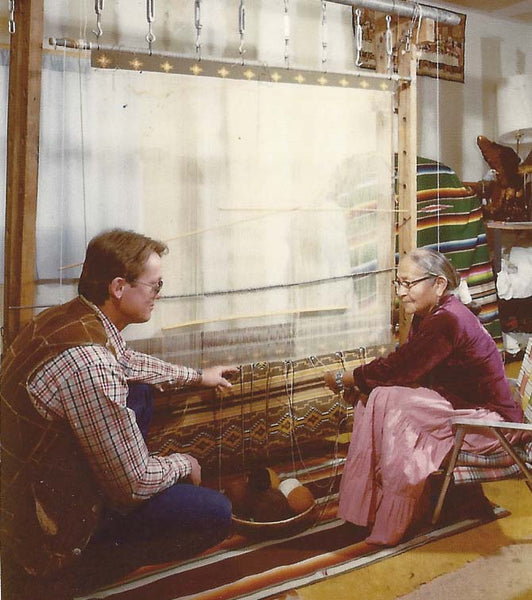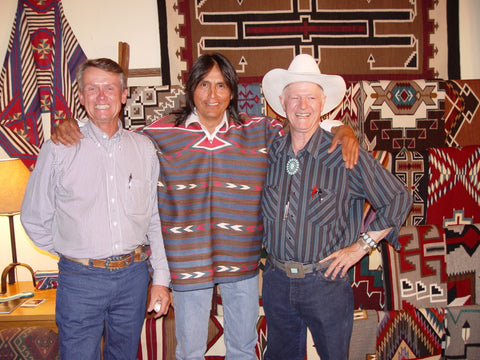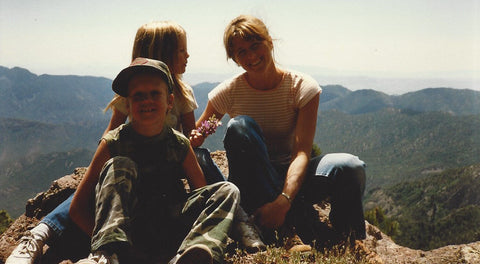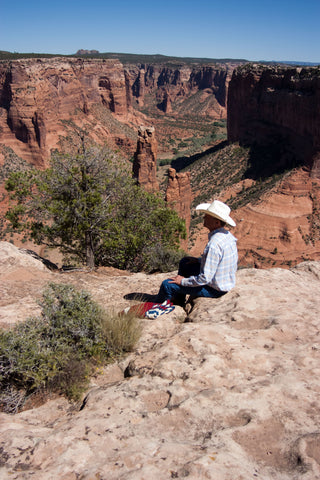Our Story- How Steve Getzwiller's Passion for Collecting Turned into The Nizhoni Ranch Gallery
The Beginning of the Getzwiller Collection
Nizhoni Ranch Gallery is built on tradition and a passion for the Native People of the Southwest. The unfolding into a world-renowned gallery took more than a few turns over the last 45+ years.
This quiet cowboy, whose ranching heritage goes back generations through Arizona and New Mexico territorial days and clear back to the Republic of Texas, is considered one of the premier collectors and dealers of Navajo weavings in the country.
In the beginning, Steve Getzwiller’s truck served as a mobile office during his monthly (sometimes bi-monthly) journeys to the Navajo reservation. As he turned off the highway onto little more than a dirt trail, bouncing across the deep ruts, his cowboy hat slid back and forth across the dashboard.
He knew just about every spot on the rez where he could get a cell phone signal. When he had one, he took the opportunity to check in with his wife, Gail, back home. For Steve, these visits weren't purely business. “It’s more a family relationship than a business one,” he says. “It’s a collaborative partnership, and when you consider I’m working exclusively with the same weavers and their children (grand children now) for 10, 20, 30 years and more, that tells you something about the relationship.” Which is, truly, a deep one.
Some of the ladies he works with are now in their 90s, (their ages range from 30s - 90s), and very few of the youngsters are taking up the craft. “There’s definitely mutual respect,” he says. “I’m their banker, employer, counselor, friend. Their problems become my problems.”
Steve knows the region well. He grew up on a ranch just east of Tucson, Arizona, and spent a lot of time as a kid around the Amerind Foundation in Dragoon, a museum and research center for Native American arts and culture. Archaeologist Charles C. Di Peso, who directed the foundation for 30 years until his death in 1982, helped to spark Steve's imagination and inspired him to study anthropology at the University of Arizona. It was then that Steve began collecting Navajo Rugs at the first opportunity.
“I was able to afford my first Navajo rug when I was 18 by trading my childhood collection of 0.22 rifles,” Steve says. “After I got out of college, I just went out and started living it…traveling to the reservation and buying and selling pawn jewelry and Navajo weavings.” At that time, he made the eight-hour trek twice a month. “In the early days, when all the trading posts were there, there was a lot of distance between trading posts, brokering the sale of several of the trading post rugs,” he recalls. “The traders used to call me a ‘hogan hopper’ when I started working directly with weavers. Interestingly enough, I’m one of the last ones standing.”
Part of Steve’s success can be attributed to the fact that from the beginning he was not simply interested in the sale, but also in enabling the women to market their work to the world. He encouraged them to experiment and expand their designs while keeping many of the traditional patterns. His philosophy dovetailed with the Diné (Navajo) to preserve their own culture while incorporating the best of others into it.
“The goal of my life’s work with the Navajo weavers has been to see how far I can push the envelope, how much I can help improve contemporary Navajo weaving and bring it to the highest level possible,” Steve says.
 By 1984, Steve wrote the book, “The Fine Art of Navajo Weaving” with the encouragement of Ray Manley. (photograph by Ray Manley: Steve and Ellen Smith at her loom) On the right, Steve sits with Master Weaver Ellen Smith (she is featured on the cover of the Fine Art of Navajo Weaving). Between Ray’s photographs, Steve’s connections and knowledge, and several trips to the Navajo Reservation, they co-published what turned out to be the best-selling book on Navajo Weaving.
By 1984, Steve wrote the book, “The Fine Art of Navajo Weaving” with the encouragement of Ray Manley. (photograph by Ray Manley: Steve and Ellen Smith at her loom) On the right, Steve sits with Master Weaver Ellen Smith (she is featured on the cover of the Fine Art of Navajo Weaving). Between Ray’s photographs, Steve’s connections and knowledge, and several trips to the Navajo Reservation, they co-published what turned out to be the best-selling book on Navajo Weaving.
Some of the special Burntwater Rugs Steve commissioned were featured in "The Fine Art of Navajo Weaving". You can read more about the Burntwater style of rugs by clicking here and Arizona Highways Magazine.
For all he’s done to improve the quality of the Navajo Rug and their marketability, Getzwiller has been likened to turn of the 19th century traders with the Navajo, Juan Lorenzo Hubbell and J.B. Moore.
Today Steve encourages the use of the traditional Churro wool, which comes from a sheep species that was nearly wiped out twice by the federal government, but still managed to survive. (This fifth-generation cattleman even purchased his own flock, which is now in the care of a Navajo family.) He has also introduced silk and alpaca fibers to traditional weavers, creating a new market of “wearable art.”
Steve wanted to give the weavers the recognition they deserved. Starting with his Polaroid camera, he would take photographs of the weavers with their rugs. He has boxes of old photographs going back to the 1970's, containing stories to be told and memories of some very great Navajo weaving artists.
Steve also collects historic weavings many of them fine antiques from different periods. “There’s no way of knowing who the early weavers were,” he says. “I can identify certain weavers by their weaving style and quality, but not who she was. That was his inspiration to establish the Navajo Churro Registry. It records each piece along with the artist who created it. “In a hundred years there will be no doubt who the weaver was and exactly which rugs they have created."
 Steve Getzwiller, Ray Tracy (wearing a Navajo Silk Poncho from the Navajo Churro Collection), and Bill Malone, famous Hubbell Trading Post Trader (now in Gallup). They were all in Santa Fe for Indian Market. They are standing in front of a display of the Navajo Churro Collection Rugs.
Steve Getzwiller, Ray Tracy (wearing a Navajo Silk Poncho from the Navajo Churro Collection), and Bill Malone, famous Hubbell Trading Post Trader (now in Gallup). They were all in Santa Fe for Indian Market. They are standing in front of a display of the Navajo Churro Collection Rugs.
Ray Tracy is a famous Navajo Jeweler/Designer, Actor & Model. If you ever get a chance to visit with Steve in person, he will be glad to tell you a few tall tales about Ray and Bill.
In 2000, the Nizhoni Ranch Gallery opened in Sonoita, Arizona. This new venue allowed Steve and Gail to offer Navajo rugs to the public in a new way; clients could come and see the weavings in a ranch house setting, up close and personal!
In 2016, the Nizhoni Ranch Gallery started presenting exhibitions of Navajo Weavings at the gallery in Sonoita. Collectors and those who appreciate authentic Navajo weavings of the highest quality come from all over the world to view these weavings in person. At exhibition opening celebrations, Master weaver, Elsie Bia comes to the gallery with her loom to show the incredible art of Navajo weaving.
Continuing Traditions
 Now that the Churro Sheep are back, weaving continues to be an important part of the Navajo's life!
Now that the Churro Sheep are back, weaving continues to be an important part of the Navajo's life!
For Steve and Gail, hardly a day goes by without them sending a deposit on a rug to a weaver or receiving a photo of a rug on the loom under construction. Every day, the Nizhoni Ranch Gallery office is also busy communicating with clients across the globe and assisting gallery visitors.
Steve and Gail are determined to continue helping the Navajo weaving tradition stay alive. It is important to keep all of the Navajo Traditions alive, including the Navajo language, customs, ceremonies, art, etc. They value and respect the Navajo in all ways as one of the nation’s first indigenous people.

As the Getzwiller collection was being built, Gail was home with the kids and running the cattle ranch when Steve went on buying trips. In the 1970's and early 80's, there were no paved roads on the Navajo Reservation, no hotels, no GPS and no cell phones. Sometimes days went by without communication between Gail at the Getzwiller ranch and Steve on the reservation. Many stories can be told about that!
Due to this, Gail was on her own, fixing everything from fences to broken water pipes, as Steve went from one place to another camping in the back of an old suburban each night on the Navajo Nation.
With the Getzwillers still collecting, there are plenty more stories to come. Check out our blog from time to time for news about what is going on around the Nizhoni Ranch. We will try to let you in on some of the stories on the back roads of the Navajo Nation and more.

